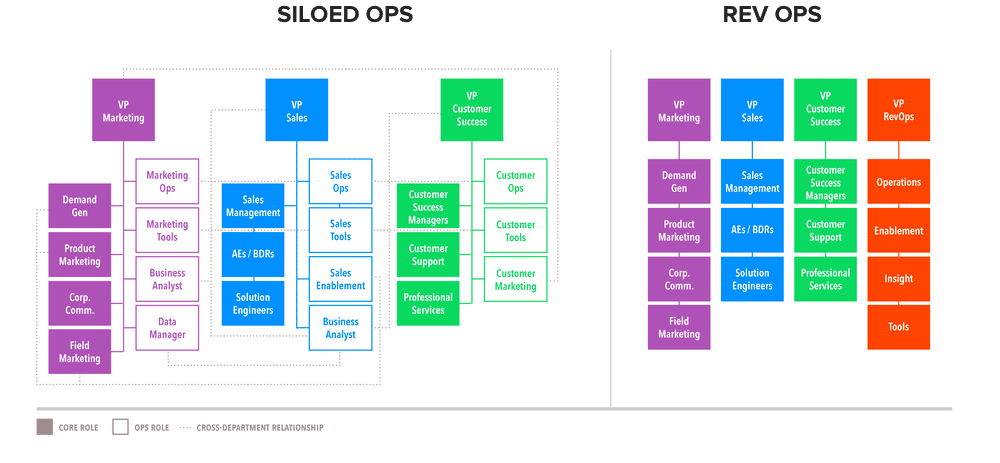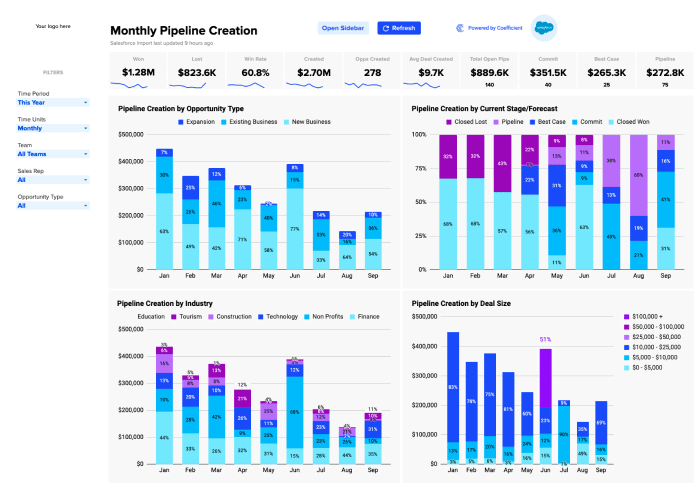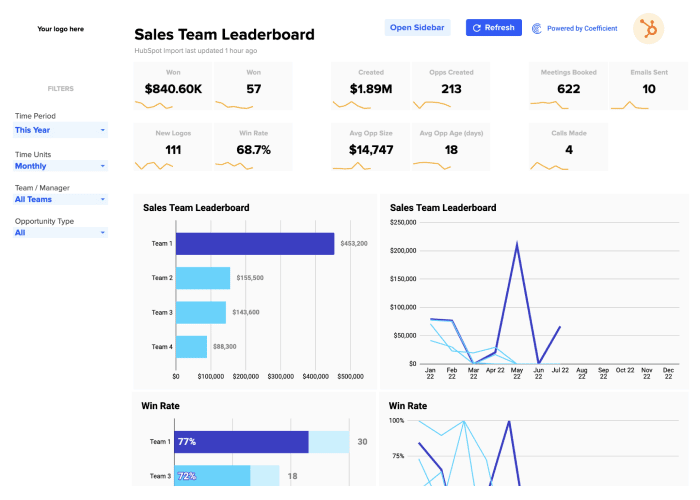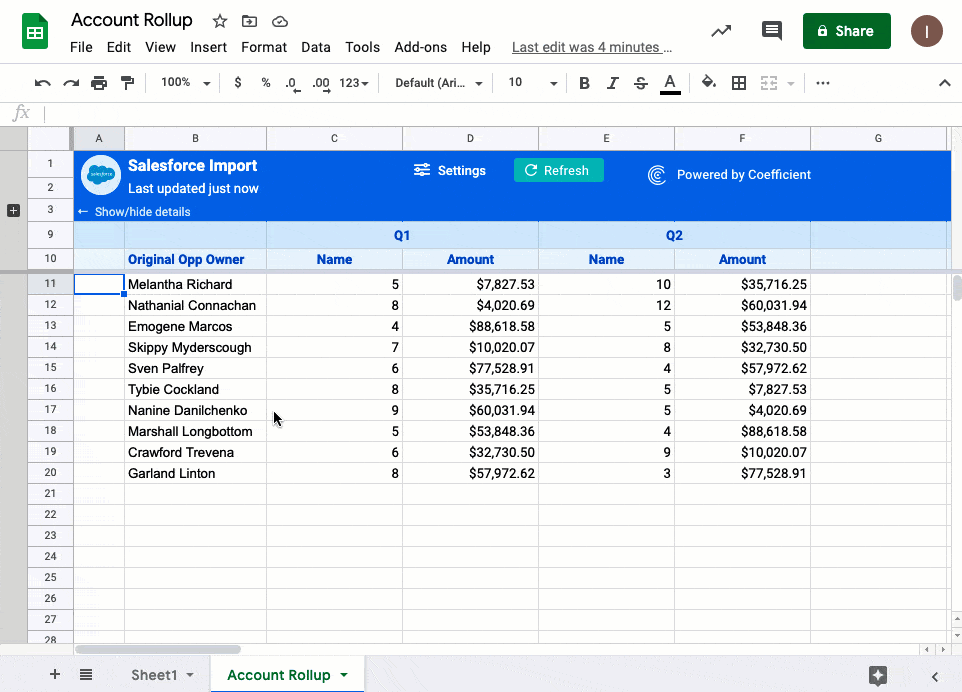Overview
With a RevOps center, you can minimize wasting resources by aligning all the processes, people, and platforms necessary to generate revenue. It also helps improve profitability, innovation, and customer satisfaction across your entire company.
While the term RevOps has been used differently in many companies and industries, leading to misunderstandings around its function, this guide will help clarify what it is and how it works.
What is RevOps and Revenue Operations Framework?
Revenue Operations or RevOps is the team, structure, and process responsible for aligning a company’s sales, marketing, executive, and customer service operations functions.
The goal of RevOps is to break down silos between these different departments and identify the most vital strategies and tools for efficiency and accountability and ultimately drive revenue growth.
RevOps allow marketers, salespeople, executives, and customer support teams to function and work together seamlessly (among other departments), optimizing the company’s ability to generate profit
The big question is, how do you align each siloed function with different goals, priorities, and incentives? And how do the different roles fit within a company?
The solution is a RevOps framework.
A Revenue Operations framework can look different for various companies and depend on the business model, revenue goals, operating plan, and other related factors.
However, a simple way of structuring your RevOps is to simplify each department’s data and tools by incorporating responsibilities associated with your enablement and operations responsibilities.

The idea is to put all these elements under your RevOps umbrella, making one entity responsible for aligning all your units’ processes and tools. This allows your departments to work together instead of treating each other as totally separate entities with different goals.
Check out this post on what is the RevOps and the Revenue Operations framework to get more comprehensive and in-depth information on the concepts.
How to structure a Revenue Operations team
There isn’t a one-size-fits-all formula to structuring a RevOps dream team. Every company has unique business needs and varying approaches depending on the size of the business.
Ultimately, you have some degree of freedom when structuring your RevOps team. Use these suggested revenue operations roles and functions as a guide to structuring your revenue operations team.
Start by outlining the basic and essential roles that every RevOps team should have, such as:
- Team lead. Team leads ensure the work of various teams align with your company goals and keep everyone on target.
- Project management team. Project management teams work collaboratively with other teams across your company on top of performing their primary functions.
- Analytics team. Dedicated analytics teams handle visualization and performance metrics to streamline generating RevOps reports and tracking.
- Platform team. Platform teams deal with governance and administrator duties for your revenue operations tech stack, including potentially high-maintenance apps or those that get high volumes of external requests.
Additionally, consider structuring your RevOps team based on the four areas of responsibility of revenue operations to ensure all functions and roles are covered. This includes:
- Operations management
- Enablement team
- Insights team
- Tools team
As your revenue operations grow, add new functions and specialize team members into specific roles required to streamline your RevOps processes.
Read this post to learn more about how to structure a revenue operations team.
Tools for effective Revenue Operations strategy (RevOps Tech Stack)
While there isn’t a perfect RevOps technology stack, focus on the software and tools that various departments (or silos) use and ones that scale with your business operations.
Here are several crucial tools to include in your tech stack:
- Customer Relationship Management (CRM) software. Essentially, using CRM software allows you to get all your customer data into a centralized location. Some of the most reliable CRM software in the market includes Salesforce, HubSpot, and Pipedrive.
- Spreadsheets. Spreadsheets are critical for RevOps because they’re powerful tools that don’t require SQL knowledge. They’re flexible, and the best part is, almost everyone knows how to use them.
Coefficient puts your spreadsheets on steroids by letting you access data where it lives, whether on Salesforce, HubSpot, Google Analytics, other spreadsheets, DB’s, BI Systems, etc. This improves your RevOps team’s “connectedness” with key departments in your company.
- Revenue Intelligence software. This type of software collects, synchronizes, and manages data across all your customer-facing teams, which helps fuel your revenue processes.
Because the technology is AI-based, it can automate and supercharge your insights to help your sales, marketing, and customer service teams drive growth.
- Project Management tools. Project management software helps your RevOps team and various departments collaborate more efficiently. It cuts down significantly on the endless back and forth and creates alignment for teams working on cross-cutting revenue initiatives.
Read this guide to learn the crucial tools for effective revenue operations strategy (RevOps Tech Stack).
The most common reports for RevOps (Revenue Operations Reporting)
Reporting provides valuable insights to help marketing teams identify ideal marketing messages, salespeople drill down on your products’ most compelling features, and customer service teams determine the gaps in your customer retention and upselling strategies.
Robust reporting and detailed dashboards allow your teams to identify trends and customer behaviors to aid them with everything from sales forecasting to all accountabilities under your RevOps’ umbrella.

Stop exporting data manually. Sync data from your business systems into Google Sheets or Excel with Coefficient and set it on a refresh schedule.
Get Started
At a glance, these are some of the key metrics you should track and generate reports on to measure RevOps success.
- Cost of customer acquisition
- Customer lifetime value
- Customer churn rate
- Monthly & annual recurring revenue
- Renewals and upsells
- Forecast accuracy
- Pipeline velocity
- Sales cycle time
- Win rates
Track the metrics that help you assess your revenue operation’s performance and effectiveness in achieving your RevOps goals.
Want to setup or enhance your reporting today? It’s possible. Launch pre-built sales dashboards in Google Sheets and sync your live data in just a few clicks.


Q&A with Revenue Operations (RevOps) leadership
Here are some of the most common questions (and answers) for RevOps team leaders and managers.
Why is revenue operations important for a company?
Revenue-driving teams and strategies that are siloed with their own goals, processes, and tools can lead to misalignment—which causes leaks in your revenue cycle.
RevOps can unify your marketing, sales, and customer service operations functions so everything and everyone is on the same page and works toward the same goal: driving more revenue and efficiencies.
What are the benefits of implementing revenue operations?
Essentially, establishing a RevOps process and structure helps you:
- Develop a whole funnel for clarity in your processes and workflows and improve your accountability.
- Make data-driven business decisions and collaboration among your revenue-generating and customer-facing teams.
- Easily generate and access centralized data and reports to predict your business’ growth.
- Speed up your sales cycle and gain higher rates of won deals.
Is SalesOps the same as RevOps?
No.
SalesOp focuses on your company’s sales function by reducing friction and refining processes in your sales cycle.
RevOps, on the other hand, is a more integrated, end-to-end approach that you implement by aligning operations and functions such as marketing and finance across your company to drive revenue.
“RevOps is part of the broader narrative about the full Go-To-Market (GTM) evolution of your revenue engine. To succeed in this journey, business leaders need to have ‘the full picture’ and be prepared for what is coming ahead of them. That is why we at RevBrains created the GTM-S blueprint, where RevOps sits in the middle of a wonderful journey toward achieving recurring success. We call it ‘Entering the GTM Singularity.’ Having a strategic partner like RevBrains by your side ensures that this transition is not only successful but also accelerates your company’s stride towards operational excellence and sustainable revenue growth.”
– George Stoyanov, Co-Founder, RevBrains
Summary
Running your business in the most efficient way possible is vital to scaling successfully. That’s why RevOps is important; it aligns your siloed and fragmented processes, tools, and teams.
When done right, RevOps can act as the framework that keeps your entire revenue-generating and customer-facing operations and strategies running smoothly to successfully grow your company.
Try Coefficient for free today!






